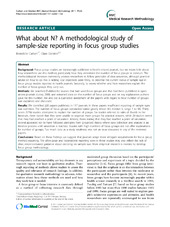| dc.contributor.author | Carlsen, Benedicte | eng |
| dc.contributor.author | Glenton, Claire | eng |
| dc.date.accessioned | 2013-09-12T10:54:41Z | |
| dc.date.accessioned | 2020-12-10T06:24:51Z | |
| dc.date.available | 2013-09-12T10:54:41Z | |
| dc.date.available | 2020-12-10T06:24:51Z | |
| dc.date.issued | 2011-03-11 | eng |
| dc.identifier.citation | BMC Medical Research Methodology 11(1):26 | eng |
| dc.identifier.issn | 1471-2288 | |
| dc.identifier.uri | https://hdl.handle.net/1956/7130 | |
| dc.description.abstract | Background: Focus group studies are increasingly published in health related journals, but we know little about how researchers use this method, particularly how they determine the number of focus groups to conduct. The methodological literature commonly advises researchers to follow principles of data saturation, although practical advise on how to do this is lacking. Our objectives were firstly, to describe the current status of sample size in focus group studies reported in health journals. Secondly, to assess whether and how researchers explain the number of focus groups they carry out. Methods: We searched PubMed for studies that had used focus groups and that had been published in open access journals during 2008, and extracted data on the number of focus groups and on any explanation authors gave for this number. We also did a qualitative assessment of the papers with regard to how number of groups was explained and discussed. Results: We identified 220 papers published in 117 journals. In these papers insufficient reporting of sample sizes was common. The number of focus groups conducted varied greatly (mean 8.4, median 5, range 1 to 96). Thirty seven (17%) studies attempted to explain the number of groups. Six studies referred to rules of thumb in the literature, three stated that they were unable to organize more groups for practical reasons, while 28 studies stated that they had reached a point of saturation. Among those stating that they had reached a point of saturation, several appeared not to have followed principles from grounded theory where data collection and analysis is an iterative process until saturation is reached. Studies with high numbers of focus groups did not offer explanations for number of groups. Too much data as a study weakness was not an issue discussed in any of the reviewed papers. Conclusions: Based on these findings we suggest that journals adopt more stringent requirements for focus group method reporting. The often poor and inconsistent reporting seen in these studies may also reflect the lack of clear, evidence-based guidance about deciding on sample size. More empirical research is needed to develop focus group methodology. | en_US |
| dc.language.iso | eng | eng |
| dc.publisher | BioMed Central | eng |
| dc.rights | Attribution 2.0 Generic (CC BY 2.0) | eng |
| dc.rights.uri | http://creativecommons.org/licenses/by/2.0/ | eng |
| dc.title | What about N? A methodological study of sample-size reporting in focus group studies | eng |
| dc.type | Journal article | eng |
| dc.type | Peer reviewed | eng |
| dc.rights.holder | Copyright 2011 Carlsen and Glenton; licensee BioMed Central Ltd. | |
| dc.date.updated | 2013-08-28T15:50:00Z | |
| dc.description.version | publishedVersion | |
| dc.description.version | Peer Reviewed | |
| dc.identifier.doi | https://doi.org/10.1186/1471-2288-11-26 | |
| dc.identifier.cristin | 787012 | |
| dc.source.journal | BMC Medical Research Methodology | |
| dc.source.volume | 11 | |
| dc.source.issue | 1 | |
| dc.source.pagenumber | 26 | |

